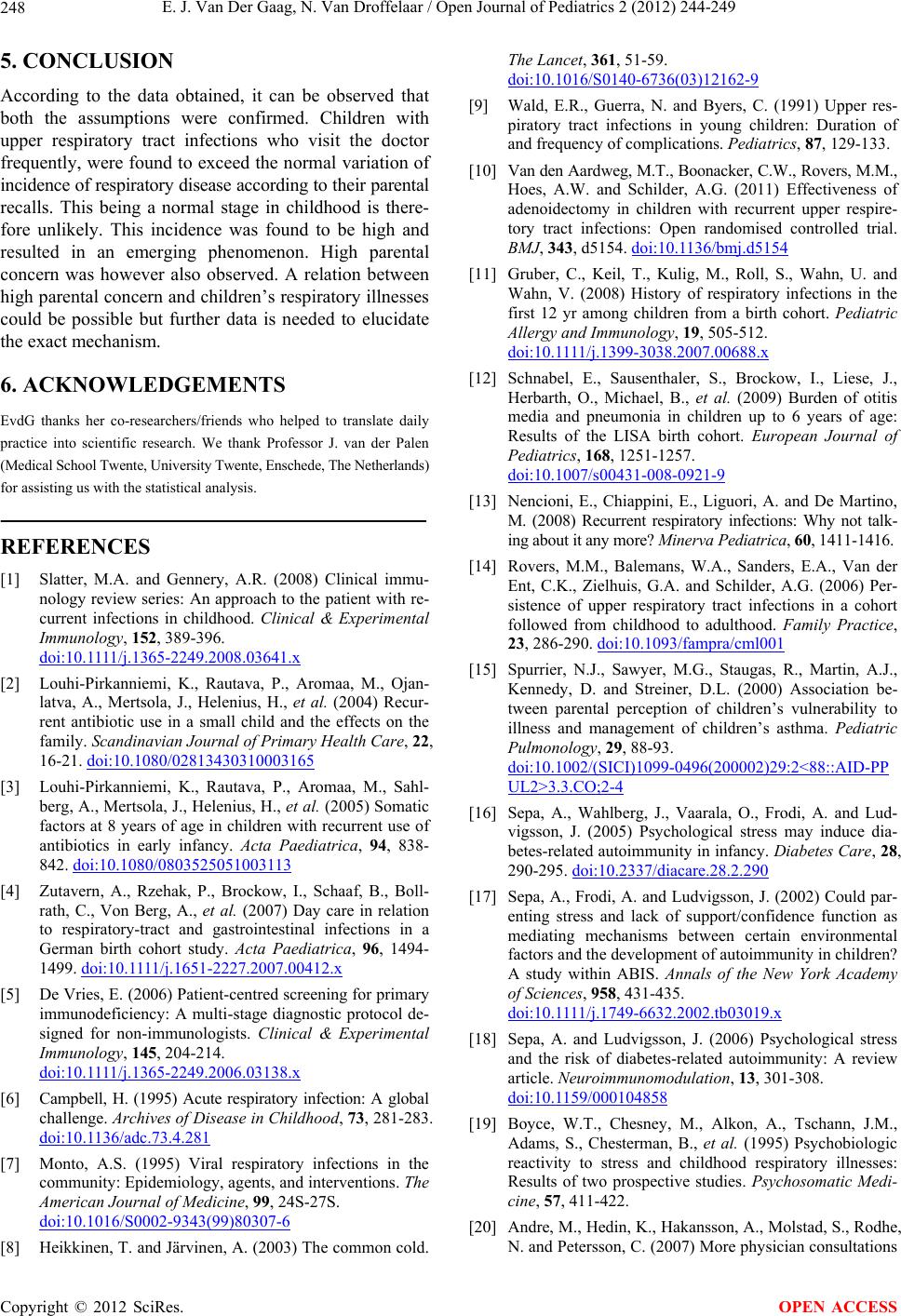
E. J. Van Der Gaag, N. Van Droffelaar / Open Journal of Pediatrics 2 (2012) 244-249
248
5. CONCLUSION
According to the data obtained, it can be observed that
both the assumptions were confirmed. Children with
upper respiratory tract infections who visit the doctor
frequently, were found to exceed the normal variation of
incidence of respiratory disease according to their parental
recalls. This being a normal stage in childhood is there-
fore unlikely. This incidence was found to be high and
resulted in an emerging phenomenon. High parental
concern was however also observed. A relation between
high parental co ncern and children ’s respiratory illnesses
could be possible but further data is needed to elucidate
the exact mechanism.
6. ACKNOWLEDGEMENTS
EvdG thanks her co-researchers/friends who helped to translate daily
practice into scientific research. We thank Professor J. van der Palen
(Medical School Twente, University Twente, Enschede, The Netherlands)
for assisting us with the statistical analysis.
REFERENCES
[1] Slatter, M.A. and Gennery, A.R. (2008) Clinical immu-
nology review series: An approach to the patient with re-
current infections in childhood. Clinical & Experimental
Immunology, 152, 389-396.
d oi:10.1111/j.1365 -2249.2008.03641.x
[2] Louhi-Pirkanniemi, K., Rautava, P., Aromaa, M., Ojan-
latva, A., Mertsola, J., Helenius, H., et al. (2004) Recur-
rent antibiotic use in a small child and the effects on the
family. Scandinavian Journal of Primary Health Care, 22,
16-21. doi:10.1080/02813430310003165
[3] Louhi-Pirkanniemi, K., Rautava, P., Aromaa, M., Sahl-
berg, A., Mertsola, J., Helenius, H., et al. (2005) Somatic
factors at 8 years of age in children with recurrent use of
antibiotics in early infancy. Acta Paediatrica, 94, 838-
842. doi:10.1080/0803525051003113
[4] Zutavern, A., Rzehak, P., Brockow, I., Schaaf, B., Boll-
rath, C., Von Berg, A., et al. (2007) Day care in relation
to respiratory-tract and gastrointestinal infections in a
German birth cohort study. Acta Paediatrica, 96, 1494-
1499. doi:10 .1111/j.1651-2227.2007.00412.x
[5] De Vries, E. (2006) Patient-centred screening for primary
immunodeficiency: A multi-stage diagnostic protocol de-
signed for non-immunologists. Clinical & Experimental
Immunology, 145, 204-214.
d oi:10.1111/j.1365 -2249.2006.03138.x
[6] Campbell, H. (1995) Acute respiratory infection: A global
challenge. Archives of Disease in Childhood, 73, 281-283.
doi:10.1136/adc.73.4.281
[7] Monto, A.S. (1995) Viral respiratory infections in the
community: Epidemiology, agents, and interventions. The
American Journal of Medicine, 99, 24S-27S.
doi:10.1016/S0002-9343(99)80307-6
[8] Heikkinen, T. and Järvinen, A. (2003) The common cold.
The Lancet, 361, 51-59.
doi:10.1016/S0140-6736(03)12162-9
[9] Wald, E.R., Guerra, N. and Byers, C. (1991) Upper res-
piratory tract infections in young children: Duration of
and frequency of complications. Pediatrics, 87, 129-133.
[10] Van den Aardweg, M.T., Boonacker, C.W., Rove rs, M.M.,
Hoes, A.W. and Schilder, A.G. (2011) Effectiveness of
adenoidectomy in children with recurrent upper respire-
tory tract infections: Open randomised controlled trial.
BMJ, 343, d5154. doi:10.1136/bmj.d5154
[11] Gruber, C., Keil, T., Kulig, M., Roll, S., Wahn, U. and
Wahn, V. (2008) History of respiratory infections in the
first 12 yr among children from a birth cohort. Pediatric
Allergy and Immunology, 19, 505-512.
d oi:10.1111/j.1399 -3038.2007.00688.x
[12] Schnabel, E., Sausenthaler, S., Brockow, I., Liese, J.,
Herbarth, O., Michael, B., et al. (2009) Burden of otitis
media and pneumonia in children up to 6 years of age:
Results of the LISA birth cohort. European Journal of
Pediatrics, 168, 1251-1257.
doi:10.1007/s00431-008-0921-9
[13] Nencioni, E., Chiappini, E., Liguori, A. and De Martino,
M. (2008) Recurrent respiratory infections: Why not talk-
ing about it any more? Minerva Pediatrica, 60, 1411-1416.
[14] Rovers, M.M., Balemans, W.A., Sanders, E.A., Van der
Ent, C.K., Zielhuis, G.A. and Schilder, A.G. (2006) Per-
sistence of upper respiratory tract infections in a cohort
followed from childhood to adulthood. Family Practice,
23, 286-290. doi:10.1093/fampra/cml001
[15] Spurrier, N.J., Sawyer, M.G., Staugas, R., Martin, A.J.,
Kennedy, D. and Streiner, D.L. (2000) Association be-
tween parental perception of children’s vulnerability to
illness and management of children’s asthma. Pediatric
Pulmonology, 29, 88-93.
doi:10.1002/(SICI)1099-0496(200002)29:2<88::AID-PP
UL2>3.3.CO;2-4
[16] Sepa, A., Wahlberg, J., Vaarala, O., Frodi, A. and Lud-
vigsson, J. (2005) Psychological stress may induce dia-
betes-related autoimmunity in infancy. Diabetes Care, 28,
290-295. doi:10.2337/diacare.28.2.290
[17] Sepa, A., Frodi, A. and Ludvigsson, J. (2002) Could par-
enting stress and lack of support/confidence function as
mediating mechanisms between certain environmental
factors and the development of autoimmunity in children?
A study within ABIS. Annals of the New York Academy
of Sciences, 958, 431-435.
d oi:10.1111/j.1749 -6632.2002.tb03019.x
[18] Sepa, A. and Ludvigsson, J. (2006) Psychological stress
and the risk of diabetes-related autoimmunity: A review
article. Neuroimmunomodulation, 13, 301-308.
doi:10.1159/000104858
[19] Boyce, W.T., Chesney, M., Alkon, A., Tschann, J.M.,
Adams, S., Chesterman, B., et al. (1995) Psychobiologic
reactivity to stress and childhood respiratory illnesses:
Results of two prospective studies. Psychosomatic Medi-
cine, 57, 411-422.
[20] Andre, M., Hedin, K., Hakansson, A., Molstad, S., Rodhe,
N. and Petersson, C. (2007) More physician consultations
Copyright © 2012 SciRes. OPEN ACCESS